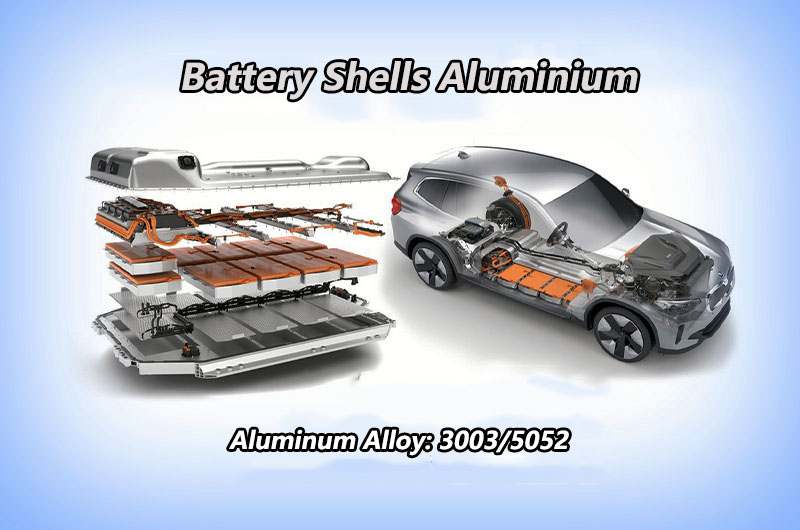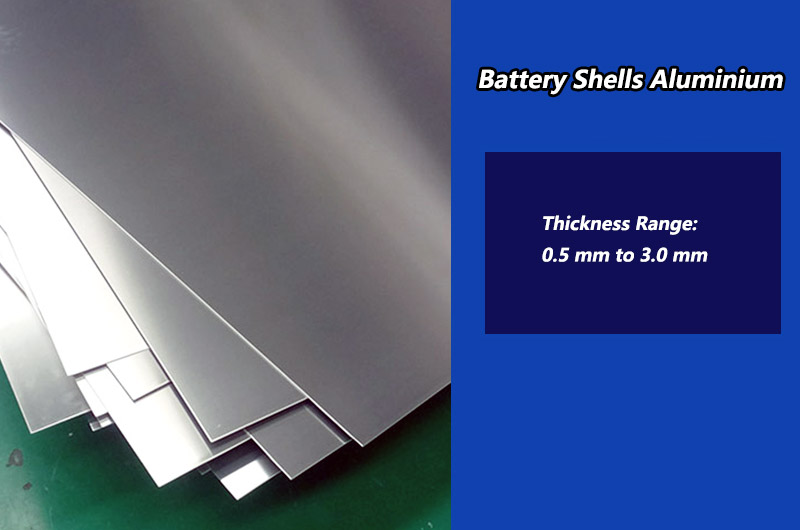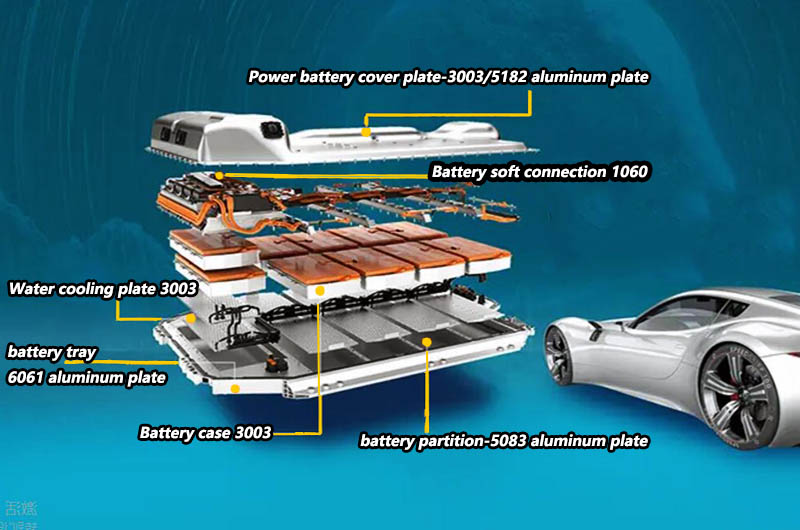- Battery Shells Aluminium Plate Sheet Advantages
- Common Thickness and Specifications of Battery Shells Aluminum Plate Sheets
- Typical Battery Shells Aluminium Plate
- Battery Shells Aluminum Plate Applications
- Requirements for Aluminum Plates for Battery Shells
- People also ask about Battery Shells Aluminium
As the demand for energy storage solutions continues to rise, the materials used in battery manufacturing play a crucial role in determining the performance, safety, and efficiency of the final product.
Aluminum plate sheets have emerged as a key component in the construction of battery shells, contributing to the evolution of energy storage technologies.

Battery Shells Aluminium Plate Sheet Advantages
1. Lightweight Strength
Aluminum's Advantage: Aluminum is renowned for its excellent strength-to-weight ratio. This property is particularly valuable in battery shell construction, where minimizing weight without compromising structural integrity is essential.
The lightweight nature of aluminum contributes to overall energy efficiency and makes batteries more portable in various applications, from electric vehicles to portable electronics.
2. Corrosion Resistance
Protection Against the Elements: Battery shells, especially those used in automotive applications, are exposed to a range of environmental conditions. Aluminum's inherent corrosion resistance ensures that battery shells remain durable and reliable even in challenging environments.
This resistance to corrosion is especially crucial for batteries in electric vehicles, where exposure to road salt and other corrosive elements is common.
3. Thermal Conductivity
Efficient Heat Dissipation: Aluminum's high thermal conductivity facilitates efficient heat dissipation from the battery. Heat management is critical in battery systems to maintain optimal performance and extend the lifespan of the cells.
Aluminum's ability to quickly conduct and dissipate heat helps prevent overheating and enhances the overall safety of the battery.
4. Formability and Design Flexibility
Tailored Solutions: Aluminum plate sheets are highly formable, allowing for the creation of intricate and custom designs. This flexibility in shaping enables the development of battery shells that can be tailored to fit specific devices or spaces.
The ability to mold aluminum into complex shapes ensures optimal use of available space and facilitates integration into diverse applications.
5. Recyclability and Sustainability
Environmentally Friendly Choice: Sustainability is a growing concern in modern manufacturing. Aluminum is a highly recyclable material, making it an environmentally friendly choice for battery shells.
The recyclability of aluminum contributes to the circular economy by reducing the environmental impact of battery production and end-of-life disposal.
6. Electrical Conductivity
Efficient Power Flow: Aluminum's excellent electrical conductivity supports efficient power flow within the battery. This property is crucial for optimizing the performance of energy storage systems, ensuring that the stored energy can be readily accessed and utilized.
7. Cost-Effectiveness
Balancing Performance and Cost: While the initial cost of aluminum may be higher than some alternative materials, the long-term benefits, including durability, lightweight design, and recyclability, contribute to overall cost-effectiveness.
The extended lifespan and efficiency of batteries with aluminum shells justify the initial investment.
Common Thickness and Specifications of Battery Shells Aluminum Plate Sheets
Battery Shells Aluminium Plate Sheet Common Thickness
Thickness Range: 0.5 mm to 3.0 mm.
Reason: Thickness varies based on the application and specific requirements of the battery design. Thicker plates may be used for heavy-duty applications, such as automotive batteries.
Battery Shells Aluminium Plate Sheet Common Specifications
- Alloy: 3003, 5083, 6061, or 1060, depending on the application.
- Temper: Typically H14, H24, or H32 for a balance of strength and formability.
- Surface Finish: Mill finish or coated for enhanced corrosion resistance.
- Width and Length: Customized based on the specific dimensions required for the battery shell design.
| Typical alloy | 5182 | 5083 | 6061 |
|---|---|---|---|
| material status | O | O | T6 |
| thickness (mm) | |||
| 1 | 1.0—2.0 | 1.0-12 | |
| typical products | Battery cover material | battery partition (battery side plate) | Battery tray |

The 3003 aluminum plate used in battery shell materials produced by Haomei Aluminum has good formability and is mainly used for deep drawing materials. The aluminum alloy plate is used as stamping parts. The plate surface is flat, clean, impact-resistant, has excellent heat dissipation performance, is light in weight, and has good forming and processing characteristics, high corrosion resistance, good weldability and electrical conductivity.
Typical Battery Shells Aluminium Plate
5182 aluminum plate for battery cover sheet
The shape of the battery shell is mainly square, usually made of 3003 aluminum alloy using a hot-rolled deep drawing process, and the battery cover is made of 5182 aluminum plate. The aluminum sheet coil produced by Haomei Aluminum hot rolling process has higher elongation, more stable performance and higher yield.
5083 aluminum plate for battery separator material (battery side plate)
The battery separator/side plate protects the battery, 5083 aluminum plate is often used. The current thickness is: 1.0/1.2/1.5/2.0 thick. 5083 belongs to the 5 series aluminum-magnesium alloy. It has excellent corrosion resistance and is easy to process. It has medium strength, low density and light weight.
6061 aluminum plate for battery tray
The battery tray is an important guarantee for the safety of the new energy vehicle battery system, and its weight accounts for 20%-30% of the battery system. It needs to be made of materials with high precision, corrosion resistance, high temperature resistance and good impact resistance. The currently widely used battery tray material is 6061 aluminum plate.
3003/3003mod aluminum plate for battery water cooling plate
The battery water-cooling plate is a component that exchanges heat through liquid cooling. The principle is to form a flow channel in the metal plate. The coolant enters from the inlet of the plate and comes out from the outlet to take away the heat generated by the battery. Alloy grades: 3003, 3003mod, 3003+4045, 3003+4343, 3003mod+4343, 3003+4004
Battery Shells Aluminum Plate Applications
| Typical alloy | 3003 | 3003 |
|---|---|---|
| material status | O | H14 |
| thickness (mm) | ||
| 1.0—3.0 | 0.6 | |
| typical products | Power battery shell | Mobile phone battery shell |

3003 H14 aluminum plate for car power battery shell
The automotive power battery aluminum shell product is made of 3003 aluminum plate, because this material is easy to process and form, has high temperature corrosion resistance, good heat transfer and conductivity, has a low density, is soft, and is easy to pull the power battery aluminum shell as a whole. Stretch forming and other advantages.
- Thickness: 0.1-500
- Product status: H14, H16, H18
3003 3005 aluminum plate for mobile phone battery case
3003 aluminum alloy has excellent comprehensive properties such as moderate strength, high plasticity, good welding performance, strong corrosion resistance, and smooth surface. It is widely used in the production of various deep-drawn products. 3003 aluminum plate has become the first choice of aluminum for mobile phone battery cases.
Requirements for Aluminum Plates for Battery Shells
1. High Purity
Reason: High purity ensures optimal electrical conductivity, contributing to efficient power flow within the battery.
2. Corrosion Resistance
Reason: Battery shells are exposed to various environmental conditions, and corrosion resistance ensures durability and longevity.
3. Formability
Reason: Formability is crucial for creating intricate and custom designs that optimize space utilization in battery shells.
4. Thermal Conductivity
Reason: Efficient heat dissipation is essential for preventing overheating and maintaining optimal battery performance.
5. Recyclability
Reason: The recyclability of aluminum aligns with sustainability goals, reducing the environmental impact of battery production and disposal.
6. Electrical Conductivity
Reason: High electrical conductivity ensures efficient power flow within the battery, contributing to performance optimization.
People also ask about Battery Shells Aluminium
- What are battery shells made of?
- Why is aluminum not used in batteries?
- Why is aluminium used for battery casing?
- Can aluminium replace lithium in batteries?
In summary, the selection of aluminum plates for battery shells depends on factors such as the application, desired properties (strength, formability, corrosion resistance), and specific design requirements.
The diverse range of aluminum alloys available allows manufacturers to tailor the material to meet the unique demands of various battery technologies and applications.
